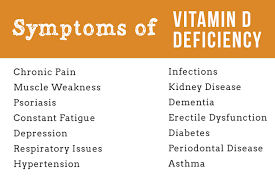Vitamin D Deficiency: Causes, Symptoms, and Biohacks
If you’re always hiding away from the sun, have milk allergies, or live on a strict vegan diet, you may be at risk of having vitamin D deficiency. Vitamin D is produced by the body when the skin is exposed to sunlight. It is also found in some foods, such as egg yolks, fish, fish liver oils, and in some grains and dairy products. Vitamin D deficiency is a growing concern.
Though generally referred to as a vitamin, vitamin D is a pro-hormone, and therefore not really a vitamin.
Unlike other vitamin nutrients which must be taken in through our diet, vitamin D is also synthesized by our body when the skin is exposed to sunlight. A 5-10 minute exposure of our skin to sunlight 2-3 times a week will produce sufficient vitamin D in most people. But since the vitamins break down a bit more quickly, the nutrients supply can run low (especially during winter).
Studies have shown that a substantial percentage of the global population has vitamin D deficiency.

What are the Notable Symptoms and Health Risks of Vitamin D Deficiency?
Basic symptoms such as bone pain and muscle weakness may be obvious signs you have a vitamin D deficiency. Symptoms can be subtle for some people. But even if you do not display symptoms, too little quantity of vitamin D can pose health risks. The following can be associated with low blood levels of vitamin D:
- Cardiovascular disease which may result in death
- Severe asthma in children
- Cognitive impairment especially in older adults
- Cancer
Basic symptoms of vitamin D deficiency include
- Bone and back pain
- Fatigue and tiredness
- Weak immune system
- Depression
- Impaired wound healing
- Bone loss
- Hair loss
- Muscle pain
Advanced cases of Vitamin D deficiency can result in
- Diabetes
- Hypertension
- Chronic Fatigue Syndrome
- Obesity
- Osteoporosis
- Fibromyalgia
- Neurodegenerative diseases, such as Alzheimer's disease
Research suggests that the presence of vitamin D in the body plays a role in preventing and treating a number of health conditions, some of which are hypertension, glucose intolerance, type1 and type 2 diabetes, and multiple sclerosis.

What could cause Vitamin D deficiency in your Body?
There are a number of reasons why Vitamin D deficiency may occur:
If you don't take in required levels of vitamin D - People who follow a strict vegan diet fall into this category because they do not take animal-based vitamin D foods such as beef liver, egg yolks, fish and fish oils, and fortified milk.
You have limited exposure to sunlight. The body makes vitamin D every time your skin is exposed to sunlight, therefore, people who are homebound, wear long robes or headgears for religious reasons, have occupations that prevent exposure, or live in northern latitudes may be at risk of vitamin deficiency.
If you have dark skin. Melanin reduces the skin's ability to produce vitamin D as the skin is exposed to sunlight. Studies have shown that older adults with darker skin risk having vitamin D deficiency.
Your kidneys are unable to convert vitamin D to its active form. The older you get, the less likely your kidneys function to adequately convert vitamin D to act the way it should, thus increasing your risk of having vitamin D deficiency.
If your digestive tract is unable to absorb vitamin D adequately. You are in this category if you suffer certain medical conditions, including Crohn's disease, celiac disease, and cystic fibrosis, this can affect the ability of your intestines to absorb vitamin D from the food you ingest.
Obese People. In this case, fat cells extract Vitamin D from the blood, altering the release of the nutrient into circulation. If you have a body mass index of 30 or more, you are likely to have low levels of vitamin D in your blood.
How to Test for Vitamin D Deficiency
The conventional way of measuring how much vitamin D you have in your body is the 25-hydroxy vitamin D blood test in a clinic or hospital. You can also do the test online by simply ordering a lab me the kit, finger pricking at the comfort of your home and posting your kit to them. Results usually show up within 48 hours. Basically, you need to have between 20 nanograms/milliliter to 50 ng/mL to be considered healthy. If you have a level of less than 12 ng/mL, that indicates you have a deficiency.
Vitamin D Deficiency Treatments and Biohacks
To treat vitamin D deficiency, all you need to do is to get more vitamin D, through the right diet and vitamin D supplements. There may not be an agreed required vitamin D levels for optimal health because it varies and depends on factors such as age and health conditions. But generally, if you have less than 20 nanograms per milliliter, you are considered inadequate and would require treatment.
The new guidelines from the Institute of Medicine recommended dietary allowance (RDA) of vitamin D to 600 international units (IU) for people between the ages 1-70, and 800 IU for older adults to optimize bone health. There is also a safe upper limit, which is 4,000 IU. Your doctor may prescribe more than 4,000 IU as a corrective measure to a deficiency.
People who don't spend much time in the sun or always have their skin covered should consult doctors for vitamin D supplements that serve people with risk factors for vitamin D deficiency.
It is advisable to continue taking vitamin D tests as you take the supplements to keep track of your progress. Testing your biomarkers and tracking your progress is quick, easy and affordable.
Abnormal test results happen - we just hope we can minimize that by allowing the patient to have full control.
Don't just leave your blood work at one time snapshots - understand what they mean over time.

